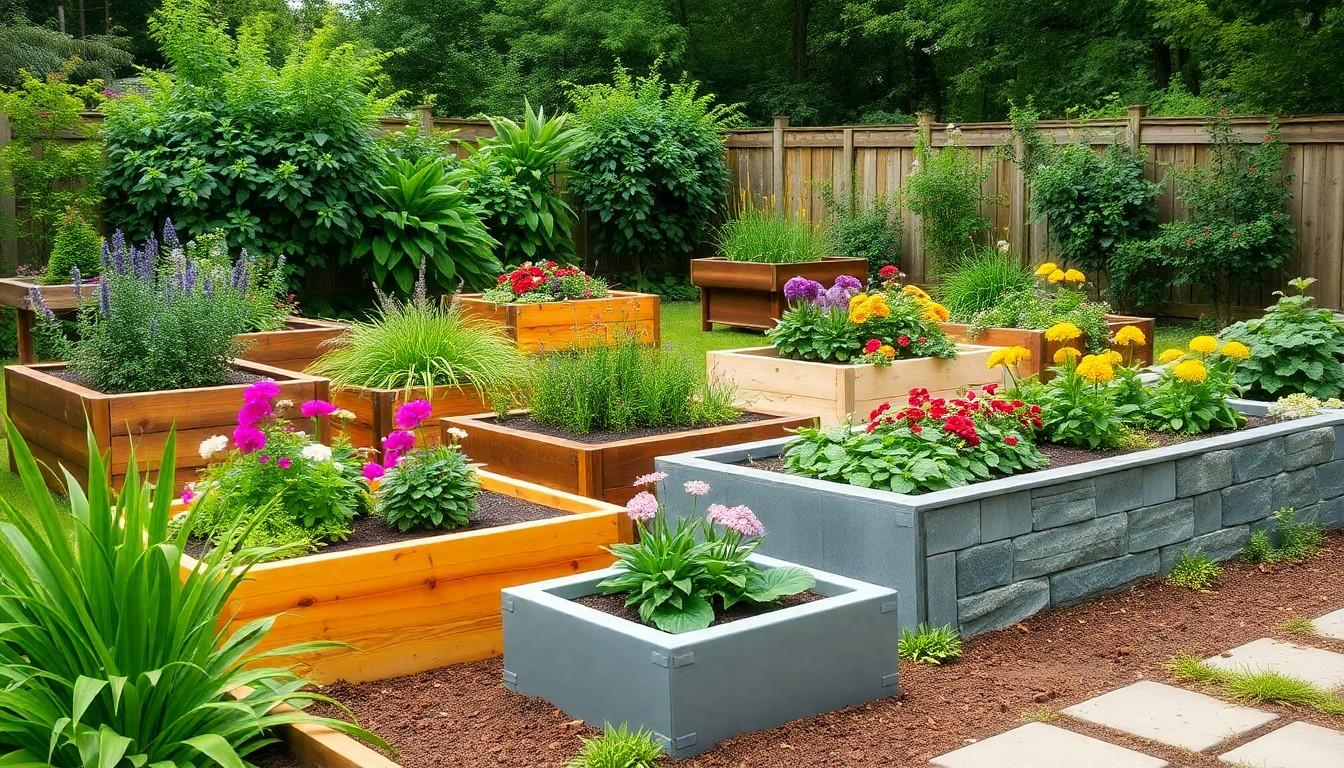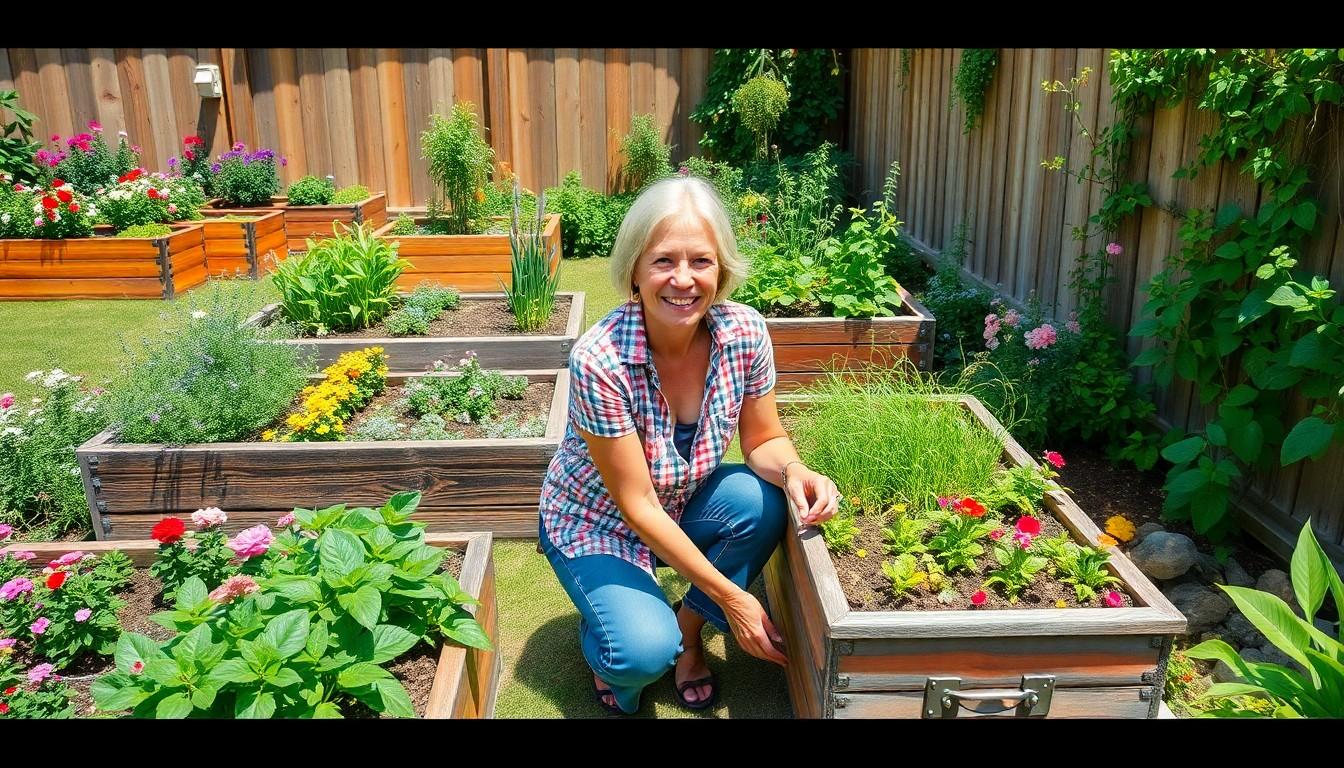Transforming an ordinary garden into a stunning oasis doesn’t have to be a chore. With the right garden bed design ideas, anyone can turn their outdoor space into a masterpiece that even Mother Nature would envy. Whether you’re a seasoned gardener or just starting out, the possibilities are endless—and so are the puns.
Garden Bed Design Ideas
Garden bed designs enhance beauty and functionality. Various styles cater to different gardening needs and aesthetics.
Raised Garden Beds
Raised garden beds elevate plants above ground level, improving drainage and warming soil. They suit various crops, including vegetables and herbs. These beds often utilize wood or metal frames, creating defined growing spaces. Custom sizes allow gardeners to maximize available area. Consider adding trellises to support climbing plants, enhancing vertical gardening.
In-Ground Garden Beds
In-ground garden beds integrate directly into the landscape. This traditional method accommodates a wide range of plants, from perennials to bushes. Convenient for larger spaces, in-ground beds promote natural biodiversity. They require less initial investment than raised options. Soil health and native plant integration enhance garden performance.
Vertical Garden Beds
Vertical garden beds utilize vertical space to grow plants. These systems maximize limited growing areas, such as balconies or small yards. Wall-mounted planters and tiered shelves provide creative displays. This technique supports various plants, including flowers and herbs. Enhancing airflow and accessibility fosters healthier growth.
Materials for Garden Beds
Selecting the right materials for garden beds enhances both durability and aesthetics. Various options exist, each offering unique benefits to garden design.
Wood
Wood remains a popular choice for garden beds due to its natural appearance and versatility. Redwood and cedar are resistant to rot and pests, making them excellent options. Pressure-treated lumber also provides durability, though care is necessary regarding chemical exposure in gardening. Each wood type adds warmth to the garden environment while being relatively easy to work with. A level surface aids in installation, ensuring stability for plants.
Metal
Metal garden beds, often made from galvanized steel or aluminum, offer longevity and modern style. Galvanized steel resists rust and corrosion, ensuring that the bed maintains its integrity over time. Aluminum is lightweight, making it easy to rearrange if desired. Another advantage includes excellent drainage and soil warmth due to the metal’s heat retention. Colors and finishes can vary, allowing for creative expression in garden design.
Stone
Stone garden beds provide a robust and natural look that enhances outdoor aesthetics. Durable options such as granite, slate, and limestone resist weathering, offering extended lifespan benefits. Each stone type can contribute to the garden’s overall design theme. Building stone beds typically involves sturdy construction methods and attention to drainage. Combining stone with native plants helps create a harmonious landscape that promotes biodiversity.
Garden Bed Design Styles
Various styles exist for garden bed designs, each offering unique aesthetics and functionality. Understanding these styles helps gardeners select the best fit for their outdoor spaces.
Traditional
Classic garden bed designs often feature symmetrical layouts and well-defined edges. They typically use straight lines, neatly arranged flower beds, and paths that lead to focal points like statues or water features. Gardeners may use rich soil and companion planting techniques to enhance biodiversity. Common plants include perennials, herbs, and vibrant annuals that add color throughout the seasons. These beds often reflect a timeless charm and are suitable for both formal and informal gardens.
Modern
Modern garden beds embrace minimalism and clean lines, often incorporating geometric shapes. These designs typically utilize materials like metal or concrete, creating a sleek, contemporary look. Plant choices focus on straight-edged arrangements and drought-tolerant species. A monochromatic color palette frequently dominates modern beds, emphasizing texture over variety. Utilizing smart technology for irrigation and monitoring showcases how design can integrate with practicality in today’s gardens.
Rustic
Rustic garden beds celebrate natural materials and organic shapes. Wood, especially reclaimed or untreated varieties, often forms the backbone of these designs. Gardens with a rustic style feature winding paths, informal layouts, and native plants that promote biodiversity. Wildflowers, ornamental grasses, and climbing vines enhance the charming character of these beds. This design approach creates a cozy, inviting atmosphere, making it perfect for informal outdoor gatherings.
Tips for Designing Your Garden Bed
Designing a garden bed requires thoughtful planning and creativity. With the right strategies, anyone can create a stunning and functional outdoor space.
Consider Your Space
Space availability significantly influences garden bed design. Assess the garden’s dimensions, sunlight exposure, and proximity to water sources. Small gardens benefit from vertical beds, which maximize planting areas without taking up ground space. Meanwhile, larger areas allow for expansive raised beds that can accommodate diverse plants. Evaluate existing landscape features like trees and pathways, ensuring the garden bed complements the surroundings. Prioritize accessibility for maintenance, ensuring paths between beds remain wide enough for tools and movement.
Choose the Right Plants
Picking plants that thrive in the selected environment enhances garden success. Consider climate and soil conditions before selecting suitable plants. Perennials provide lasting color, while annuals can add seasonal variety. Native plants often require less maintenance and support local wildlife, promoting biodiversity. Group plants based on sunlight preferences and growth habits, which creates visual harmony and encourages healthier growth. Utilize companion planting techniques to maximize resources and deter pests, while ensuring each plant type harmonizes with others.
Incorporate Accessories
Accessories can elevate a garden bed’s aesthetics and functionality. Consider trellises, which support climbing plants, adding vertical interest to the garden. Decorative stones or mulch in pathways enhance visual appeal and improve drainage. Raised bed edging options, such as metal or wood, create defined borders to enhance structure while preventing soil erosion. Adding garden art like sculptures or bird feeders fosters a welcoming atmosphere for both people and wildlife. Utilize lighting solutions to accentuate beautiful features and extend outdoor enjoyment into the evening hours.
Transforming a garden into a stunning oasis is within reach for everyone. With a variety of garden bed designs available there’s an option to suit every taste and space. Whether opting for raised beds to improve drainage or vertical designs to maximize limited areas each choice enhances both beauty and functionality.
Selecting the right materials can further elevate the garden’s appeal while ensuring durability. From the warmth of wood to the sleekness of metal and the timelessness of stone each material plays a vital role in the overall aesthetic.
By thoughtfully planning and incorporating unique accessories gardeners can create a personalized outdoor retreat. Embracing creativity and understanding different styles allows anyone to cultivate a garden that reflects their vision and enhances their outdoor experience.


